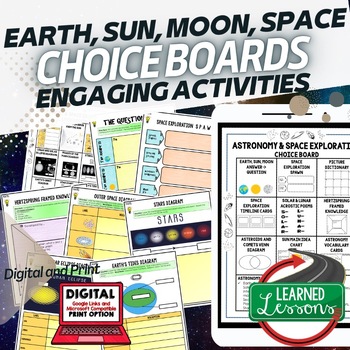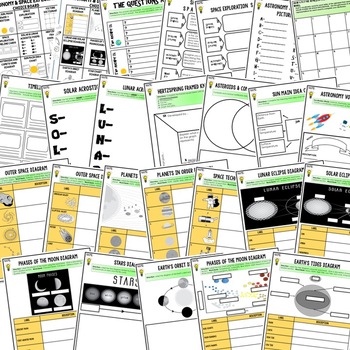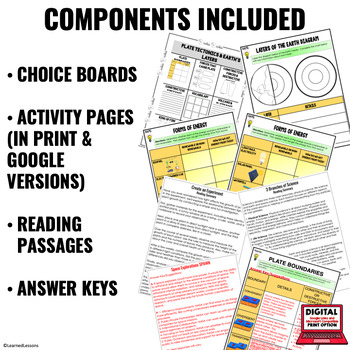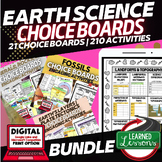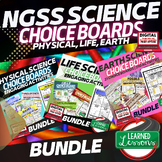Earth Sun Moon Activities Solar System & Planets Choice Board Space Exploration
- PDF
- Google Apps™

What educators are saying
Also included in
- Earth Science Astronomy and Space Exploration BUNDLE, Google Classroom, Print & Digital LearningClick Here for Earth Science MEGA BUNDLEINCLUDED IN THIS BUNDLE:Astronomy & Space Warm Ups & Bell Ringers, NGSS 6-8 ScienceAstronomy and Space Exploration Student and Teacher Guided NotesAstroPrice $22.00Original Price $68.50Save $46.50
- Earth Science Choice Board Activities BUNDLE (Google and Paper Versions) | Earth Science Activity | DifferentiationEarth Science Graphic Organizers, Earth Science Digital Interactive Notebook, Earth Science Summer School, Earth Science Google Activities ALSO PART OF EARTH SCIENCE MEGA BUNDLEIncludesPrice $24.00Original Price $44.75Save $20.75
- NGSS 6-8 Science Activities and Choice Boards BUNDLE, Life Science Activities, Earth Science Activities, Physical Science Activities NGSS Activities, NGSS Choice Boards, Physical Science Choice Boards, Life Science Choice Boards, Earth Science Choice BoardsThese activity pages are engaging and thougPrice $67.00Original Price $104.25Save $37.25
Learning Objective
Students will complete activities that are differentiated by choice, content, and level. These print and digital graphic organizers will guide students through research and engagement with the content of the unit. Choice board included.
Description
Astronomy and Space Exploration Choice Board with Activity Research Organizers, Google Classroom, Print & Digital Distance Learning | Earth Science Activity | Differentiation
Earth Science Graphic Organizers, Earth Science Digital Interactive Notebook, Earth Science Summer School, Earth Science Google Activities
INCLUDED IN SEVERAL BUNDLE TO SAVE $$$:
- Astronomy and Space Exploration BUNDLE
- EARTH SCIENCE MEGA BUNDLE
- EARTH SCIENCE CHOICE BOARDS (Google or Paper Versions)
Includes:
- 2 pages of choices
- 19 Activities
- 36 Pages (Black/White and Digital Option)
Topics Included:
- Earth, Sun, Moon
- Space Explorations
- Space Technology
- Solar System
- Timeline of Space Exploration
- Solar and Lunar
- Hertzsprung Diagram
- Asteroids and Comets
- Solstices, Equinoxes, Solar Eclipse, Lunar Eclipse, and Tides
- Outer Space Diagram
- Planets
- Space Technology
- Phases of the Moon
- Star Diagram
- Earth's Orbit
- Star Chart
- Earth's Tides
Instructions for using this packet:
- Option 1: These pages can be given to students and the teacher can have the students complete all activities as they study the unit.
- Option 2: These pages can be given to students and the teacher can have students choose a certain number of activities to complete as they progress through the unit of study.
- Option 3: These pages can be used to remediate and provide additional practice to students that are struggling with certain content or certain skills.
- Option 4: These pages can be used as a review activity to prepare for unit tests, quarterly exams, mid-term exams, or end of the course state assessments.
FOLLOW TO GET UPDATES WHEN NEW RESOURCES ARE ADDED
Links to all MEGA BUNDLES
- Civics and Government MEGA Bundle
- Economics/Free Enterprise MEGA Bundle
- American History MEGA Bundle Colonial US to Reconstruction
- American History MEGA Bundle Western Frontier to President Trump
- World Geography MEGA Bundle
- World History Part 1 MEGA Bundle
- World History Part 2 MEGA Bundle
- English MEGA Bundle
- Physical Science MEGA Bundle
- Life Science MEGA Bundle
- Earth Science MEGA Bundle
Other Resources to Check Out:
- Social Studies MEGA BUNDLES
- Deals $2 and Under
- Social Studies Word Walls
- Social Studies Anchor Charts
- Social Studies Picture Puzzles
- Social Studies Games
- Social Studies Cut and Paste
- Social Studies DBQs and Speeches
- Social Studies Timelines
- Social Studies Choice Boards
- Social Studies Graphic Organizers
- SCIENCE MEGA BUNDLES
- Deals $2 and Under
- Science Word Walls
- Science Anchor Charts
- Science Picture Puzzles
- Science Games
- Science Cut and Paste
- Science Guided Notes
- Science I Cans
- Science Choice Boards
- Science Graphic Organizers
CIVICS PAGE
US HISTORY PAGE
ELA & WRITING PAGE
PHYSICAL SCIENCE PAGE
PHYSICAL SCIENCE RESOURCE PAGE
EARTH SCIENCE PAGE
LIFE SCIENCE PAGE
WORLD HISTORY PAGE
GEOGRAPHY PAGE
LOUISIANA HISTORY PAGE
CLIPART RESOURCE PAGE
Thank you for your support! --Learned Lessons
Leaned Lessons Teaching Material
learnedlessonstpt@gmail.com
#TPTDIGITAL #TPTTECH Google, 1:1, Digital

